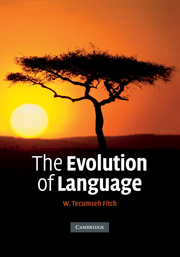Book contents
- Frontmatter
- Contents
- List of figures
- Acknowledgments
- Introduction
- SECTION 1 THE LAY OF THE LAND
- SECTION 2 MEET THE ANCESTORS
- 5 Meet the ancestors
- 6 The LCA: our last common ancestor with chimpanzees
- 7 Hominid paleontology and archaeology
- SECTION 3 THE EVOLUTION OF SPEECH
- SECTION 4 EVALUATING PHYLOGENETIC MODELS OF LANGUAGE EVOLUTION
- Glossary
- Appendix: species names
- References
- Author index
- Subject index
- Species index
6 - The LCA: our last common ancestor with chimpanzees
Published online by Cambridge University Press: 05 June 2012
- Frontmatter
- Contents
- List of figures
- Acknowledgments
- Introduction
- SECTION 1 THE LAY OF THE LAND
- SECTION 2 MEET THE ANCESTORS
- 5 Meet the ancestors
- 6 The LCA: our last common ancestor with chimpanzees
- 7 Hominid paleontology and archaeology
- SECTION 3 THE EVOLUTION OF SPEECH
- SECTION 4 EVALUATING PHYLOGENETIC MODELS OF LANGUAGE EVOLUTION
- Glossary
- Appendix: species names
- References
- Author index
- Subject index
- Species index
Summary
Reconstructing the LCA
In the previous chapter we surveyed the vast sweep of evolution from the unicellular beginnings of life to the flourishing of primates in the Tertiary. We have arrived at a point crucial for our own evolutionary history: the evolution of hominids sensu strictu starting with our divergence from chimpanzees about seven million years ago (in the upper Miocene). This was the time of our last common ancestor with chimpanzees, or LCA, which was an African ape, probably confined to the forests stretching across the middle of Africa. These last seven million years have obviously been a period of considerable divergence of humans from chimpanzees and most other primates, with changes in locomotion, dentition, reproductive physiology, behavior, and brain size. We are fortunate to have a rich fossil record for later sections of this period for hominids (in striking contrast to our nearly non-existent record for chimpanzees or gorillas, who were living and evolving in Africa simultaneously). We have no fossils of the LCA, though new fossils from this time period give hope for such discoveries in the future (Brunet et al., 2005). Thus, in order to reconstruct the lifeways of the LCA we need to turn to the comparative method, focusing particularly on the great apes (Wrangham, 1987; Foley, 1995). Thanks to decades of concerted efforts by field and laboratory researchers, our knowledge of chimpanzee behavior is now quite rich (Goodall, 1986; Tomasello and Call, 1997; Boesch and Boesch-Achermann, 2000).
- Type
- Chapter
- Information
- The Evolution of Language , pp. 234 - 249Publisher: Cambridge University PressPrint publication year: 2010

